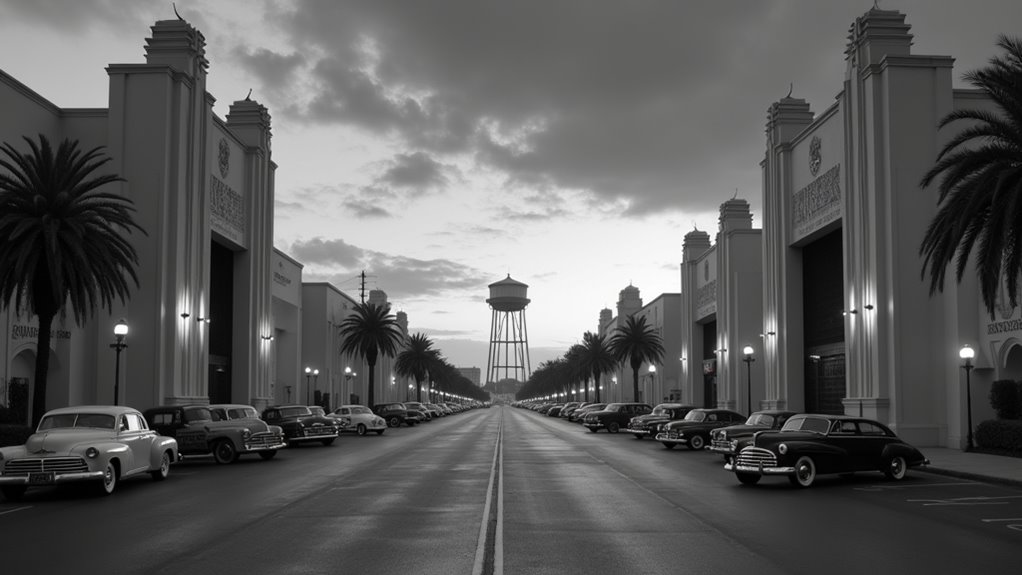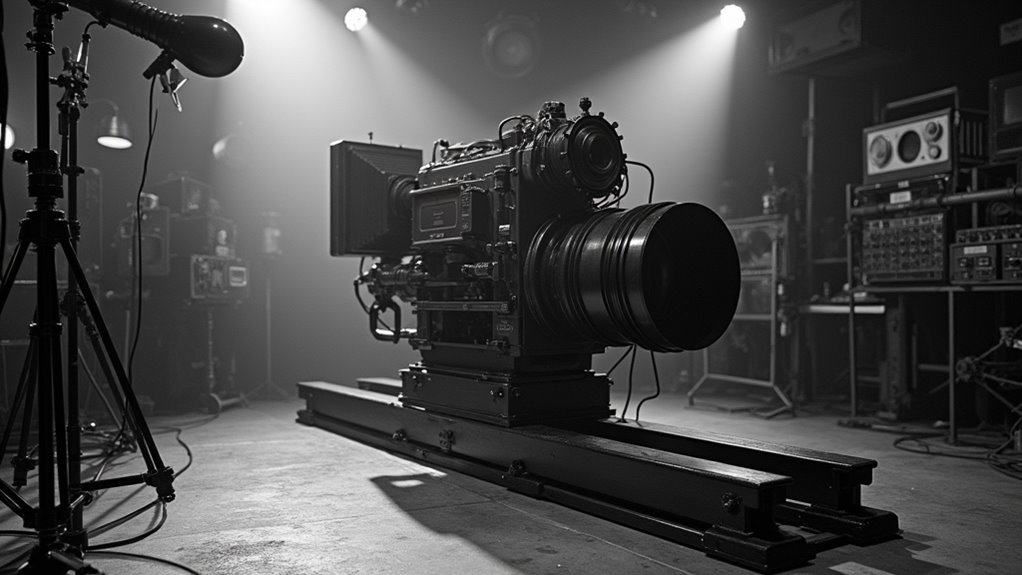Hollywood’s Golden Age revolutionized cinema through a powerful combination of studio control and creative innovation. The major studios’ vertically integrated system, which dominated from the late 1920s through the 1950s, created an assembly line of talent that produced timeless classics like Casablanca and Gone with the Wind. With groundbreaking technical advances, iconic stars like Katharine Hepburn and Clark Gable, and masterful storytelling techniques, this era established Hollywood as the world’s premier dream factory, setting standards that would influence filmmaking for generations.
The Studio System’s Revolutionary Impact on Cinema

The studio system of Hollywood’s Golden Age represented one of the most efficient and influential models of entertainment production in history. Through a tightly controlled vertical integration structure, major studios like MGM, Paramount, and Warner Bros. operated as well-oiled machines, churning out films with assembly-line precision while maintaining surprisingly high artistic standards. The factory-like approach to movie production established a stable system that kept the industry thriving for decades.
The system’s genius lay in its comprehensive approach, with studios wielding power over every aspect of filmmaking. By keeping talent under exclusive long-term contracts, maintaining in-house creative teams, and controlling distribution channels, these entertainment powerhouses created a foundation for consistent quality that modern Hollywood still strives to match. The controversial practice of block booking packages forced theaters to accept multiple films from studios, ensuring steady revenue streams. This era gave rise to pioneering directors like Alfred Hitchcock, whose masterful touch helped define the artistic possibilities of cinema.
While critics might view this factory-like approach as creatively stifling, it paradoxically gave birth to timeless classics like Gone with the Wind and Casablanca. The arrangement wasn’t perfect – just ask any actor trapped in a seven-year contract – but it created a golden standard for streamlined production that transformed movies from novelty entertainment into a cultural cornerstone.
Stars, Style, and Storytelling: The Elements of Golden Age Magic
While modern Hollywood dazzles audiences with CGI spectacles and billion-dollar franchises, Golden Age cinema captured hearts through an intoxicating blend of star power, sophisticated style, and masterful storytelling techniques.
The era’s magnetic personalities, from Katharine Hepburn and Cary Grant to Clark Gable and Greta Garbo, weren’t just actors – they were cultural phenomena who shaped fashion trends both on and off screen. Following the Pioneer Era of experimental filmmaking, these stars helped establish cinema as a legitimate art form. Their carefully crafted personas meshed perfectly with the period’s signature storytelling approaches, which ranged from the shadowy aesthetics of film noir to the technicolor dreams of musicals like The Wizard of Oz. The introduction of sound in films transformed the theatrical experience, making movies more immersive than ever before. The development of three-strip Technicolor brought unprecedented visual richness to the screen, particularly evident in epic productions.
These elements combined to create timeless classics like Casablanca and Gone with the Wind, which served both as escapist entertainment during the Great Depression and as vehicles for exploring deeper societal themes.
The resulting creative alchemy established Hollywood as the world’s premier dream factory, whose influence continues to reverberate through contemporary cinema.
Technical Breakthroughs That Changed Movies Forever

Behind every glamorous star and polished performance of Hollywood’s Golden Age stood an army of technical innovators who fundamentally transformed the art of moviemaking.
The watershed moment came in 1927 when “The Jazz Singer” introduced synchronized sound, forever silencing the silent era and ushering in the age of “talkies.” This revolutionary breakthrough was quickly followed by the standardization of 24 frames per second playback, ensuring seamless audio-visual integration across theaters nationwide.
The 1930s brought another game-changer with Technicolor, painting the silver screen in vivid hues that turned “The Wizard of Oz” and “Gone with the Wind” into visual feasts. The Big Five Studios dominated the industry during this period, controlling nearly all aspects of film production and distribution. The three-strip process pioneered by Technicolor first made its feature-length debut in “Becky Sharp” in 1935.
Meanwhile, pioneering filmmakers like D.W. Griffith mastered deep focus photography, while new techniques like the 180-degree rule and match-on-action cuts created the seamless visual language we now take for granted. Naturalistic acting styles emerged during this era, revolutionizing performance techniques on screen.
These innovations, combined with the efficiency of the studio system’s vertical integration, established technical standards that continue to influence filmmaking nearly a century later.
Frequently Asked Questions
How Did the Great Depression Affect Movie Attendance During Hollywood’s Golden Age?
Movie attendance experienced significant fluctuations during the Depression, initially plummeting from 110 million weekly viewers in 1930 to around 60-75 million by 1933.
However, theaters adapted through innovative strategies like double features, “Bank Night” promotions, and reduced ticket prices.
Despite economic hardships, cinema remained a popular escape, with attendance rebounding to approximately 80 million weekly viewers through these creative audience-building tactics.
What Role Did Censorship Play in Shaping Golden Age Films?
Censorship through the Hays Code fundamentally shaped Golden Age films by forcing directors to get creative with storytelling.
Rather than showing explicit content, filmmakers mastered the art of suggestion through clever dialogue, symbolic imagery, and strategic camera angles.
This constraint paradoxically led to more sophisticated narratives, with classics like “Casablanca” delivering complex themes through subtle implications rather than overt displays.
How Did World War II Influence the Themes of Hollywood Movies?
World War II dramatically transformed Hollywood’s thematic landscape, pushing studios to produce patriotic propaganda films that boosted morale and supported the war effort.
Under the Office of War Information’s guidance, movies like “Casablanca” wove anti-Nazi messaging into compelling narratives, while combat films glorified American heroism.
Studios balanced escapist entertainment with wartime messaging, often sanitizing war’s harsh realities while emphasizing themes of sacrifice, unity, and victory.
Which Foreign Film Markets Were Most Important During Hollywood’s Golden Age?
During Hollywood’s Golden Age, European markets, particularly the United Kingdom, France, and Germany, proved most crucial for American film distribution.
These nations offered significant box office returns and cultural resonance with Hollywood productions.
Latin America emerged as another vital market, benefiting from shared linguistic ties through Spanish-language films.
While Asian markets showed promise, cultural barriers and local regulations often limited Hollywood’s reach in these regions.
How Did Radio Entertainment Compete With Golden Age Cinema?
Radio challenged cinema through its free accessibility and diverse programming, offering everything from soap operas to live music broadcasts.
While movies required ticket purchases, radio brought entertainment directly into homes, featuring many Hollywood stars who crossed over to voice acting.
Radio’s innovative storytelling, exemplified by shows like “The War of the Worlds,” and heavy sponsorship model created fierce competition for audience attention during entertainment’s golden years.
